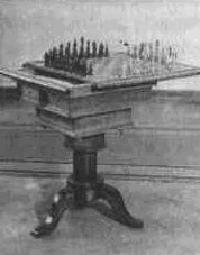The Second Congress of the Russian Social-Democratic
Labour Party.
The Beginning of the Bolshevik
Party.
Chess table with the hidden box for documents."As a current of political thought and as
a political party, Bolshevism has existed since 1903."
V. I. Lenin actively participated in the work of the Congress. More than 130 speeches, retorts and remarks by him are recorded in the minutes. Several of these are presented in the exposition. A moment during one of Lenin's speeches is portrayed In Y.Vinogradov's painting, "The Second Congress of the Russian Social-Democratic Labour Party". The Congress adopted the Party Programme drawn up by Iskra editorship. For the first time in the history of the international workers' movement after the death of K. Marx and F. Engels, a revolutionary programme was adopted in which the struggle for the dictatorship of the proletariat was set forth as the basic task of the working class. The first edition of the Programme is displayed in the hall. An open and decisive struggle took place at the Congress. Lenin later recalled his conversation with one of the Congress delegates taking a centrist position. "'How oppressive the atmosphere is at our congress!' he complained. 'This bitter fighting, this agitation one against the other, this biting controversy, this uncomradely attitude!...' 'What a splendid thing our Congress is!' I replied. 'A free and open struggle. Opinions have been stated. The shades have been revealed. The groups have taken shape. Hands have been raised. A decision has been taken. A stage has been passed. Forward! That's the stuff for me! That's life! That's not like the endless, tedious word-chopping of your intellectuals, which stops not because the question has been settled, but because they are too tired to talk any more. ...' The comrade of the 'Centre' stared at me in perplexity and shrugged his shoulders. We were talking different languages." Among the documents on display is Lenin's manuscript of the draft of the first paragraph of the Party Rules, and one of his notes made during the discussion of the rules at the congress: "... the distinction between those Who merely talk and those who work: it is better not to name as members ten workers than name one chatterer." Lenin considered the Party a militant organisation. Every member must actively participate in the revolutionary Struggle and submit to Party discipline. The opponents of Lenin and his confederates proposed accepting Into the Party all those wishing to enter, without obliging them to be members of one of its organisations and without restraining limits of Party discipline. In the elections to central bodies of the Party, the supporters of Lenin received the majority of votes. It was precisely from this time that they were called Bolsheviks, while their opponents, opportunists who were in the minority, were named Mensheviks. Thus at the Second Congress a proletarian party was formed, a party of a new type, Lenin's Bolshevik Party. The victory of Lenin's plan for the formation of a Party of social revolution and the dictatorship of the proletariat demonstrated that the Russian and international proletariat found in Lenin an outstanding theoretician who continued the work and teachings of Marx and Engels, a strategist of the revolution who foresaw the perspectives for the development of the workers' movement. Materials are displayed in the hall which characterise Lenin's implacable struggle against the Mensheviks after the Second Congress. Also on display are resolutions and letters of Bolshevik committees from various cities in support of Lenin's decisions accepted at the Second Congress of the Russian Social-Democratic Labour Party. In the central display are the first edition of V. I. Lenin's book One Step Forward, Two Steps Back published in Geneva in 1904, and its editions in the various national languages of the USSR and foreign countries. In his work, Lenin outlined the organisational principles of Bolshevism, the norms of Party life and the principles of Party leadership, which became the rules for all subsequent Party activities.
Geneva.During his period of emigration, Lenin, as always, worked a great deal. From 1903 to 1904 he often used the university library in Geneva. A chair from this library is an exhibit item in this hall. Here also is a chess table, made according to Lenin's instructions with a secret compartment for the preservation of illegal Party documents and letters. Concluding the hall's display are documents and materials illustrating V. I. Lenin's preparation for the Party's Third Congress. The Bolshevik newspaper Vperyod (Forward) played a significant role in this, reviving the revolutionary traditions of Iskra. The first issue was printed December 22, 1904 (January 4, 1905) in Geneva. It contained several articles by Lenin. An original copy of this issue, an announcement of the newspaper's publication and photographs of the editors are presented in the exposition. First Russian Revolution (1905 - 1907) |

